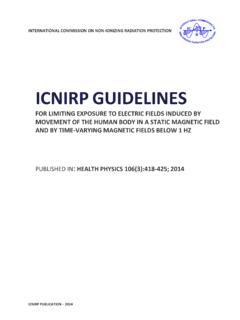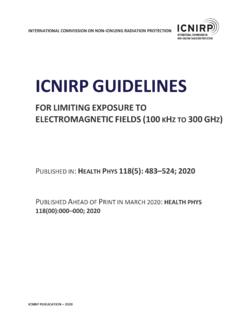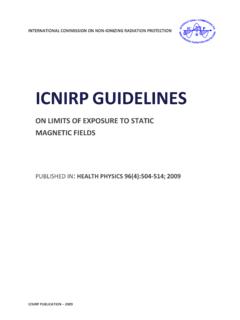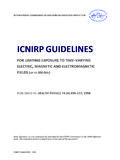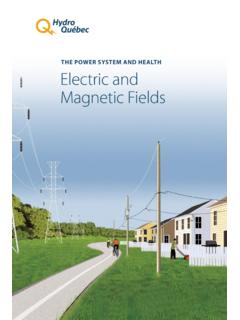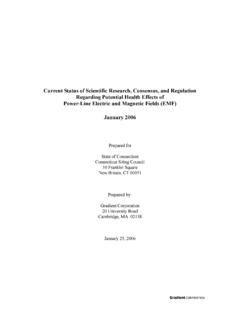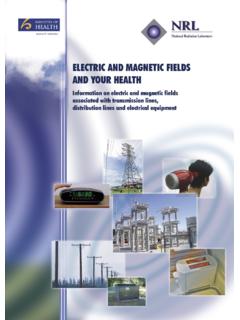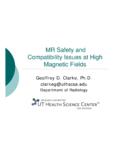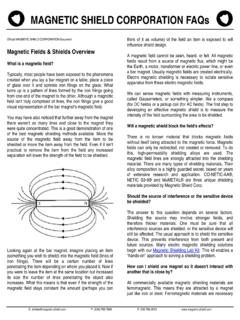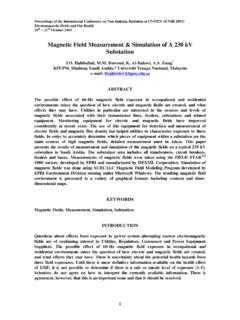Transcription of ICNIRP GUIDELINES
1 INTERNATIONAL COMMISSION ON NON IONIZING RADIATION PROTECTION ICNIRP PUBLICATION 2010 ICNIRP GUIDELINES FOR LIMITING EXPOSURE TO TIME VARYING electric AND magnetic FIELDS (1 HZ 100 kHZ) PUBLISHED IN: HEALTH PHYSICS 99(6):818 836; 2010 ICNIRP GuidelinesGUIDELINES FOR LIMITING EXPOSURE TO TIME-VARYINGELECTRIC AND magnetic FIELDS (1 Hz TO 100 kHz)International Commission on Non-Ionizing Radiation Protection*INTRODUCTIONIN THIS document, GUIDELINES are established for the protec-tion of humans exposed to electric and magnetic fields inthe low-frequency range of the electromagnetic general principles for the development of ICNIRP GUIDELINES are published elsewhere ( ICNIRP 2002). For thepurpose of this document, the low-frequency range extendsfrom 1 Hz to 100 kHz.
2 Above 100 kHz, effects such asheating need to be considered, which are covered by otherICNIRP GUIDELINES . However, in the frequency range from100 kHz up to approximately 10 MHz protection from both,low frequency effects on the nervous system as well as highfrequency effects need to be considered depending onexposureconditions. Therefore, some guidance in thisdocument is extended to 10 MHz to cover the nervoussystem effects in this frequency range. GUIDELINES forstatic magnetic fields have been issued in a separatedocument ( ICNIRP 2009). GUIDELINES applicable tomovement-induced electric fields or time-varying mag-netic fields up to 1 Hz will be published publication replaces the low-frequency part ofthe 1998 GUIDELINES ( ICNIRP 1998). ICNIRP is currentlyrevising the GUIDELINES for the high-frequency portion ofthe spectrum (above 100 kHz).
3 SCOPE AND PURPOSEThe main objective of this publication is to establishguidelines for limiting exposure to electric and magneticfields (EMF) that will provide protection against allestablished adverse health on both direct and indirect effects of EMF havebeen assessed: direct effects result from direct interactionsof fields with the body; indirect effects involve interactionswith a conducting object where the electric potential of theobject is different from that of the body. Results of labora-tory and epidemiological studies, basic exposure assessmentcriteria, and reference levels for practical hazard assessmentare discussed, and the GUIDELINES presented here are appli-cable to both occupational and public restrictions in these GUIDELINES were based onestablished evidence regarding acute effects; currentlyavailable knowledge indicates that adherence to these re-strictions protect workers and members of the public fromadverse health effects from exposure to low frequencyEMF.
4 The epidemiological and biological data concerningchronic conditions were carefully reviewed and it wasconcluded that there is no compelling evidence that they arecausally related to low-frequency EMF GUIDELINES do not address product perfor-mance standards, which are intended to limit EMFemissions from specific devices under specified testconditions, nor does the document deal with the tech-niques used to measure any of the physical quantities thatcharacterize electric , magnetic and electromagneticfields. Comprehensive descriptions of instrumentationand measurement techniques for accurately determiningsuch physical quantities may be found elsewhere (IEC2004, 2005a; IEEE 1994, 2008).Compliance with the present GUIDELINES may not nec-essarily preclude interference with, or effects on, medicaldevices such as metallic prostheses, cardiac pacemakers andimplanted defibrillators and cochlear implants.
5 Interferencewith pacemakers may occur at levels below the recom-mended reference levels. Advice on avoiding these prob-lems is beyond the scope of the present document but isavailable elsewhere (IEC 2005b).These GUIDELINES will be periodically revised andupdated as advances are made in the scientific knowledgeconcerning any aspect relevant for limiting exposure of lowfrequency time-varying electric and magnetic AND UNITSW hereas electric fields are associated only with thepresence of electric charge, magnetic fields are the result* ICNIRP Secretariat, c/o Gunde Ziegelberger, c/o Bundesamt fu rStrahlenschutz, Ingolstaedter Landstrasse 1, 85764 Oberschleissheim, correspondence or reprints contact accepted15 June2010)0017-9078/10/0 Copyright 2010 Health Physics SocietyDOI: the physical movement of electric charge (electriccurrent).
6 An electric field ,E, exerts a force on an electriccharge and is expressed in volts per meter (V m 1).Similarly, magnetic fields can exert physical forces onelectric charges, if such charges are in motion and/or themagnetic field varies with time. electric and magneticfields have both magnitude and direction ( , they arevectors). A magnetic field can be specified in twoways as magnetic flux density,B, expressed in tesla(T), or as magnetic field strength,H, expressed in ampereper meter (A m 1). The two quantities are related by theexpression:B H(1)where is the constant of proportionality (the magneticpermeability); in vacuum and air, as well as in non- magnetic (including biological) materials, has thevalue 4 10 7when expressed in Henry per meter (Hm 1). Thus, in describing a magnetic field for protectionpurposes, only one of the quantitiesBorHneeds to to time-varying EMF results in internalelectric fields and in body currents and energy absorptionin tissues that depend on the coupling mechanisms andthe frequency involved.
7 The internal electric fieldEiandcurrent densityJare related by Ohm s Law:J Ei(2)where is the electrical conductivity of the medium. Thedosimetric quantities used in these GUIDELINES are asfollows: electric fieldEi; and general summary of EMF and dosimetric quantities andunits used in these GUIDELINES is provided in Table BASIS FOR LIMITING EXPOSURET hese GUIDELINES for limiting exposure have beendeveloped following a thorough review of the publishedscientific literature. Well established criteria were used toevaluate the scientific validity of the methodology, re-sults and conclusions of reported findings. Only effectsfor which there was reliable scientific evidence wereused as the basis for the exposure effects of exposure to low frequencyelectromagnetic fields have been reviewed by theInternational Agency for Research on Cancer (IARC), ICNIRP , and the World Health Organization (WHO)(IARC 2002; ICNIRP 2003a; WHO 2007a) and na-tional expert groups.
8 Those publications provided thescientific basis for these detailed below, the basis for the GUIDELINES istwo-fold: Exposure to low-frequency electric fields maycause well-defined biological responses, ranging fromperception to annoyance, through surface electric -chargeeffects. In addition, the only well established effects involunteers exposed to low frequency magnetic fields arethe stimulation of central and peripheral nervous tissuesand the induction in the retina of phosphenes, a percep-tion of faint flickering light in the periphery of the visualfield. The retina is part of the CNS and is regarded as anappropriate, albeit conservative, model for induced elec-tric field effects on CNS neuronal circuitry in view of the uncertainty inherent in the scientificdata, reduction factors have been applied in establishingthe exposure GUIDELINES .
9 For details see ICNIRP mechanisms between fields and the bodyHuman and animal bodies significantly perturb thespatial distribution of a low frequency electric field . Atlow frequencies, the body is a good conductor, and theperturbed field lines external to the body are nearlyperpendicular to the body surface. Oscillating charges areinduced on the surface of the exposed body and theseproduce currents inside the body. Key features of dosim-etry for exposure of humans to low frequency electricfields include: the electric field induced inside the body is consider-ably smaller than the external electric field , , five tosix orders of magnitude at 50 60 Hz; for a given external electric field , the strongest fieldsare induced when the human body is in perfect contactwith the ground through the feet (electricallygrounded), and the weakest induced fields are for thebody insulated from the ground (in free space ); the total current flowing in a body in perfect contactwith ground is determined by the body size and shape(including posture) rather than tissue conductivity.
10 The distribution of induced currents across the variousorgans and tissues is determined by the conductivity ofthose tissues; andTable and corresponding SI units used inthese Siemens per meter (S m 1)CurrentIAmpere (A)Current densityJAmpere per square meter (A m 2)FrequencyfHertz (Hz) electric field strengthEVolt per meter (V m 1) magnetic field strengthHAmpere per meter (A m 1) magnetic flux densityBTesla (T) magnetic permeability Henry per meter (H m 1)Permittivity Farad per meter (F m 1)819 Limiting exposure to time-varying electric and magnetic fields ICNIRP there is also an indirect effect, where the current in thebody is produced by contact with a conductive objectlocated in an electric magnetic fields, the permeability of tissue is thesame as that of air, so the field in tissue is the same as theexternal field .

